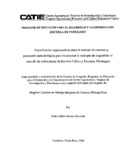| dc.contributor.advisor | Jiménez, F. | |
| dc.contributor.author | Orozco Bucardo, P.P. | |
| dc.contributor.other | CATIE - Centro Agronómico Tropical de Investigación y Enseñanza | |
| dc.date.accessioned | 2014-10-18T02:29:15Z | |
| dc.date.available | 2014-10-18T02:29:15Z | |
| dc.date.issued | 2006 | es_ES |
| dc.identifier | 369691 | es_ES |
| dc.identifier.uri | https://repositorio.catie.ac.cr/handle/11554/3274 | |
| dc.description | Tesis (Mag.) -- CATIE, 2006 | es_ES |
| dc.description.abstract | La investigación fue realizada en las subcuencas de los ríos Cálico y Jucuapa en Nicaragua, con el objetivo de analizar y sistematizar experiencias del papel de la organización en el manejo y la cogestión de esas subcuencas hidrográficas. Se analizó el relacionamiento institucional y su evolución durante los últimos seis años, así como el funcionamiento de los Comités de Agua Potable y Saneamiento (CAPS). Con base en los resultados y otras experiencias se desarrolló una propuesta metodológica para consolidar la aplicación del enfoque de cogestión en cuencas abastecedoras de agua para consumo humano. Los resultados indican que el relacionamiento interinstitucional está incrementado en ambas subcuencas. La red de organismos que trabajan en temas sociales se encuentra desvinculada de los que trabajan en manejo de recursos naturales y se hace necesario que ambas subredes encuentren los puntos de coincidencia.
This study was conducted in the Cálico river and Jucuapa river watersheds in Nicaragua, with the objective to analyze and systematize experiences on the role of organization on management and co-management in these hydrographic watersheds. Institutional relationships and their evolution during the past six years were analyzed along the function of the Potable Water and Sanitation Committees (CAPS) and their potential for acting as local watershed committees. Based on the results from above and other experiences, a proposed methodology was developed to consolidate the application of co-management in the tributary watersheds for water for human consumption. The results indicate that the inter-institutional relationship is increasing in both watersheds. The institutional network that works in social topics is not linked to those who work in natural resource management, it is necessary for both sub-networks to find points which coincide. | es_ES |
| dc.language.iso | es | es_ES |
| dc.publisher | CATIE, Turrialba (Costa Rica) | es_ES |
| dc.relation.ispartof | Maestría en Manejo y Gestión en Cuencas Hidrográficas | |
| dc.rights | info:eu-repo/semantics/openAccess | es_ES |
| dc.subject | NICARAGUA | |
| dc.subject | CUENCAS HIDROGRÁFICAS | |
| dc.subject | ORDENACIÓN DE CUENCAS | |
| dc.subject | ORDENACIÓN DE RECURSOS | |
| dc.subject | GESTIÓN | |
| dc.subject | PLANIFICACIÓN | |
| dc.subject | ABASTECIMIENTO DE AGUA | |
| dc.subject | AGUA POTABLE | |
| dc.subject | PARTICIPACIÓN SOCIAL | |
| dc.subject.other | Sede Central | |
| dc.title | Experiencias organizativas para el manejo de cuencas y propuesta metodológica para incorporar el enfoque de cogestión: el caso de las subcuencas de los ríos Cálico y Jucuapa, Nicaragua | es_ES |
| dc.title.alternative | Organizational experiences for watershed management and proposed methodology for incorporating the focus of co-management: a case study from the Cálico river and Jucuapa river watersheds, Nicaragua | es_ES |
| dc.type | Tesis de maestría | es_ES |


